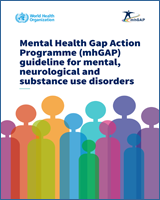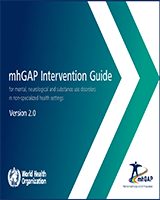The psychoses module covers management of two severe mental health conditions, psychosis and bipolar disorder. People with psychosis or bipolar disorder are at high risk of exposure to stigma, discrimination and violation of their right to live with dignity.
Psychosis is characterised by distorted thoughts and perceptions, as well as disturbed emotions and behaviours. Incoherent or irrelevant speech may also be present. Symptoms such as hallucinations – hearing voices, or seeing things that are not there; delusions – fixed, false beliefs; severe abnormalities of behaviour – disorganised behaviour, agitation, excitement, inactivity, or hyperactivity; disturbances of emotion – marked apathy, or disconnect between reported emotion and observed affect, such as facial expression and body language, may also be detected.
Bipolar disorder is characterized by episodes in which the person's mood and activity levels are significantly disturbed. This disturbance consists on some occasions of an elevation of mood and increased energy and activity (mania), and on others of a lowering of mood and decreased energy and activity (depression). Characteristically, recovery is complete between episodes. People who experience only manic episodes are also classified as having bipolar disorder.
PSY 1. Assessment

TABLE 5Management of Persons with Agitated and/or Aggressive Behaviour
View in own window
| ASSESSMENT | COMMUNICATION | SEDATION AND USE OF MEDICATION |
|---|
- »
Attempt to communicate with the person. - »
Evaluate for underlying cause: - –
Check Blood Glucose. If low, give glucose. - –
Check vital signs, including temperature and oxygen saturation. Give oxygen if needed. - –
Rule out delirium and medical causes including poisoning. - –
Rule out drug and alcohol use. Specifically consider stimulant intoxication and/or alcohol/sedative withdrawal. Go to »
SUB. - –
Rule out agitation due to psychosis or manic episode in bipolar disorder. Go to Assessment, » PSY 1.
|
- »
Safety is first! - »
Remain calm and encourage the patient to talk about his or her concerns. - »
Use a calm voice and try to address the concerns if possible. - »
Listen attentively. Devote time to the person. - »
Never laugh at the person. - »
Do not be aggressive back. - »
Try to find the source of the problem and solutions for the person. - »
Involve carers and other staff members. - »
Remove from the situation anyone who may be a trigger for the aggression. - »
If all possibilities have been exhausted and the person is still aggressive, it may be necessary to use medication (if available) to prevent injury.
|
- »
Sedate as appropriate to prevent injury. - »
For agitation due to psychosis or mania, consider use of haloperidol 2mg p.o./i.m. hourly up to 5 doses (maximum 10 mg). Caution: high doses of haloperidol can cause dystonic reactions. Use biperiden to treat acute reactions. - »
For agitation due to ingestion of substances, such as alcohol/sedative withdrawal or stimulant intoxication, use diazepam 10-20 mg p.o. and repeat as needed. Go to »
SUB. In cases of extreme violence - –
Seek help from police or staff - –
Use haloperidol 5mg i.m., repeat in 15-30mins if needed (maximum 15 mg) - –
Consult a specialist.
- »
if the person remains agitated, recheck oxygen saturation, vital signs and glucose. Consider pain. Refer to hospital. - »
Once agitation subsides, refer to the master chart (MC) and select relevant modules for assessment.
|
PSY 2. Management

PSYCHOSOCIAL INTERVENTIONS
2.1. Psychoeducation
Key messages for the person and their carers
- »
Explain that the symptoms are due to a mental health condition, that psychosis and bipolar disorders can be treated, and that the person can recover. Clarify common misconceptions about psychosis and bipolar disorder.
- »
Do not blame the person or their family or accuse them of being the cause of the symptoms.
- »
Educate the person and the family that the person needs to take the prescribed medications and return for follow-up regularly.
- »
Explain that return and/or worsening of symptoms are common and that it is important to recognize these early and visit to the health facility as soon as possible.
- »
Plan a regular work or school schedule that avoids sleep deprivation and stress for both the person and the carers. Encourage the person to solicit advice about major decisions especially ones involving money or major commitments.
- »
Recommend avoiding alcohol, cannabis or other non-prescription drugs, as they can worsen the psychotic or bipolar symptoms.
- »
Advise them about maintaining a healthy lifestyle, e.g. a balanced diet, physical activity, regular sleep, good personal hygiene, and no stressors. Stress can worsen psychotic symptoms. Note: Lifestyle changes should be continued as long as needed, potentially indefinitely. These changes should be planned and developed for sustainability.
CLINICAL TIP
Build rapport with the person.
Mutual trust between the person and the health-care provider is critical to ensure treatment adherence and long-term outcomes.
2.2. Reduce stress and strengthen social supports
- »
Coordinate with available health and social resources to meet the family's physical, social, and mental health needs.
- »
Identify the person's prior social activities that, if reinitiated, would have the potential to provide direct or indirect psychological and social support, e.g. family gatherings, outings with friends, visiting neighbors, social activities at work sites, sports, and community activities. Encourage the person to resume these social activities and advise family members about this.
- »
Encourage the person and carers to improve social support systems.
CLINICAL TIP
Ensure persons with psychosis are treated with respect and dignity. For further details go to » ECP.
2.3. Promote functioning in daily living activities
- »
Continue regular social, educational and occupational activities as much as possible. It is best for the person to have a job or to be otherwise meaningfully occupied.
- »
Facilitate inclusion in economic activities, including culturally appropriate supported employment.
- »
Offer life skills training and/or social skills training to enhance independent living skills for people with psychosis and bipolar disorders and for their families and/or carers.
- »
Facilitate, if available and needed, independent living and supported housing that is culturally and contextually appropriate in the community.
2.4. General advice for carers
- »
Do not try to convince the person that his or her beliefs or experiences are false or not real. Try to be neutral and supportive, even when the person shows unusual behaviour.
- »
Avoid expressing constant or severe criticism or hostility towards the person with psychosis.
- »
Give the person freedom of movement. Avoid restraining the person, while also ensuring that their basic security and that of others is met.
- »
In general it is better for the person to live with family or community members in a supportive environment outside of the hospital setting. Long-term hospitalization should be avoided.
PHARMACOLOGICAL INTERVENTIONS
FOR SPECIAL POPULATIONS, (women who are pregnant or breastfeeding, children/adolescents, and older adults), see detailed recommendations.
2.5. Psychosis
- »
Antipsychotics should routinely be offered to a person with psychosis.
- »
Start antipsychotic medication immediately. See .
- »
Prescribe one antipsychotic at a time.
- »
Start at lowest dose and titrate up slowly to reduce risk of side effects.
- »
Try the medication at a typically effective dose for at least 4-6 weeks before considering it ineffective.
- »
Continue to monitor at that dose as frequently as possible and as required for the first 4-6 weeks of therapy. If there is no improvement, see Follow-up and .
- »
Monitor weight, blood pressure, fasting sugar, cholesterol and ECG for persons on antipsychotics if possible (see below).
Antipsychotic medications.
Review adherence, side effects and dosing based on clinical situation/presentation.
CAUTION!
- »
Side effects to look for:
- –
Extrapyramidal side effects (EPS): akathisia, acute dystonic reactions, tremor, cog- wheeling, muscular rigidity, and tardive dyskinesia. Treat with anticholinergic medications when indicated and available (see ).
- –
Metabolic changes: weight gain, high blood pressure, increased blood sugar and cholesterol.
- –
ECG changes (prolonged QT interval): monitor ECG if possible.
- –
Neuroleptic malignant syndrome (NMS): a rare, potentially life-threatening disorder characterized by muscular rigidity, elevated temperature, and high blood pressure.
Anticholinergic medications. (for treatment of extrapyramidal side effects (EPS)Avoid in women who are pregnant or breastfeeding if possible.
2.6. Manic Episode in Bipolar Disorder
If patient is on antidepressants:
- »
DISCONTINUE ANTIDEPRESSANTS to prevent further risk of mania.
- »
Begin treatment with lithium, valproate, carbamazepine, or with antipsychotics (see ).
Lithium: consider using lithium as first line treatment of bipolar disorder only if clinical and laboratory monitoring are available, and prescribe only under specialist supervision. If laboratory examinations are not available or feasible, lithium should be avoided and valproate or carbamazepine should be considered. Erratic compliance or stopping lithium treatment suddenly may increase the risk of relapse. Do not prescribe lithium where the lithium supply may be frequently interrupted. Obtain kidney and thyroid function, complete blood count, ECG, and pregnancy tests before beginning treatment if possible.
Valproate and Carbamazepine: Consider these medications if clinical or laboratory monitoring for lithium is not available or if specialist is not available to supervise lithium prescription.
Haloperidol and risperidone: consider haloperidol and risperidone only if no clinical or laboratory monitoring is available to start lithium or valproate. Risperidone can be used as an alternative to haloperidol in individuals with bipolar mania if availability can be assured, and cost is not a constraint.
CAUTION
For women who are pregnant or breastfeeding, avoid valproate, lithium and carbamazepine. Use of low-dose haloperidol is recommended with caution and under the care of a specialist, if available.
- »
Consider a short term (2-4 weeks maximum) benzodiazepine for behavioural disturbances or agitation:
- –
Persons with mania who are experiencing agitation may benefit from short-term ( 2-4 weeks maximum) use of a benzodiazepine such as diazepam.
- –
Benzodiazepines should be discontinued gradually as soon as symptoms improve, as tolerance can develop.
- »
Continue maintenance treatment for at least 2 years after the last bipolar episode.
- –
Lithium or valproate can be offered for the maintenance treatment of bipolar disorder. If treatment with one of these agents is not feasible, haloperidol, chloropromazine or carbamazepine may be used.
Offer maintenance treatment in primary care settings under specialist supervision.
Mood stabilizers. Avoid in women who are pregnant or breastfeeding if possible.
PSY 3. Follow-up
MANIC EPISODE IN BIPOLAR DISORDER



